Pinsa, also known as Pinsa Romana is an oval-shaped pizza made with a mix of three different flours that can be topped with a variety of toppings, much similar to those of classic pizza.
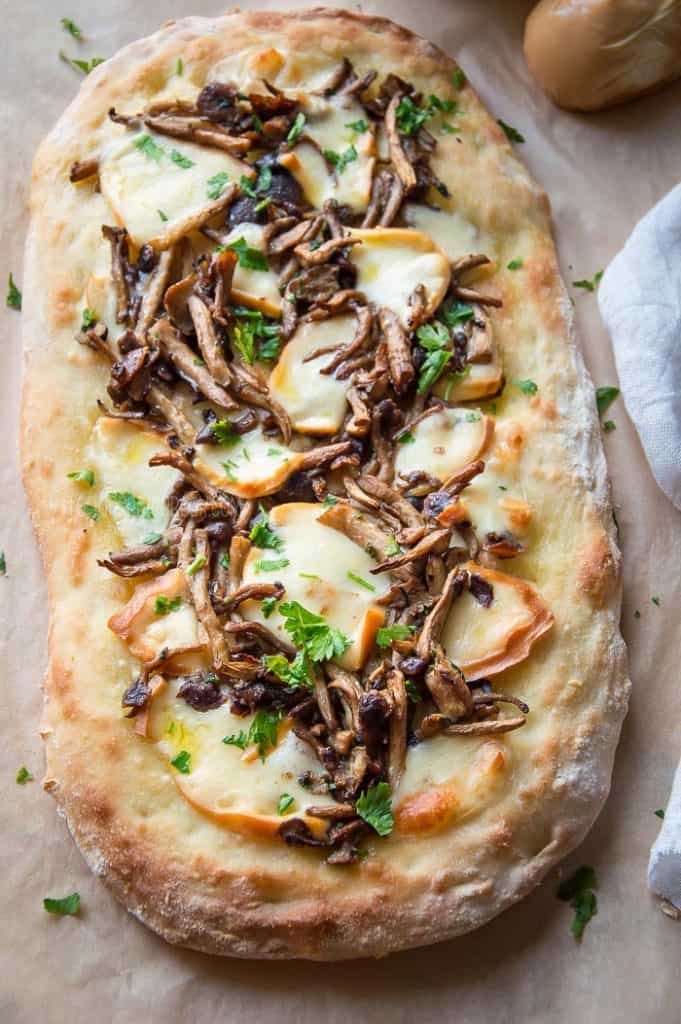
Table Of Contents
What is Pinsa?
Pinsa, pronounced “PEEN-sah” is an Italian oval-shaped pizza originated in Rome in the beginning of the 21st century, invented by Corrado Di Marco and his father. The main difference between Pizza and Pinsa is that the later is made with a mix of 3 different flours: wheat, soy and rice.
Pinsa Romana: Characterictics
- Originally made with 3 flours: wheat, soy and rice flour.
Note: since soy flour is not easy to find, this recipe has been adapted further to use only wheat and rice flour obtaining very similar results. - Elongated oval shape
- High percentage of hydration - 80% which results in light big bubbles
- Light and easy to digest due to the mix of flours and long cold fermentation in the fridge.
- Delicious crispy crust
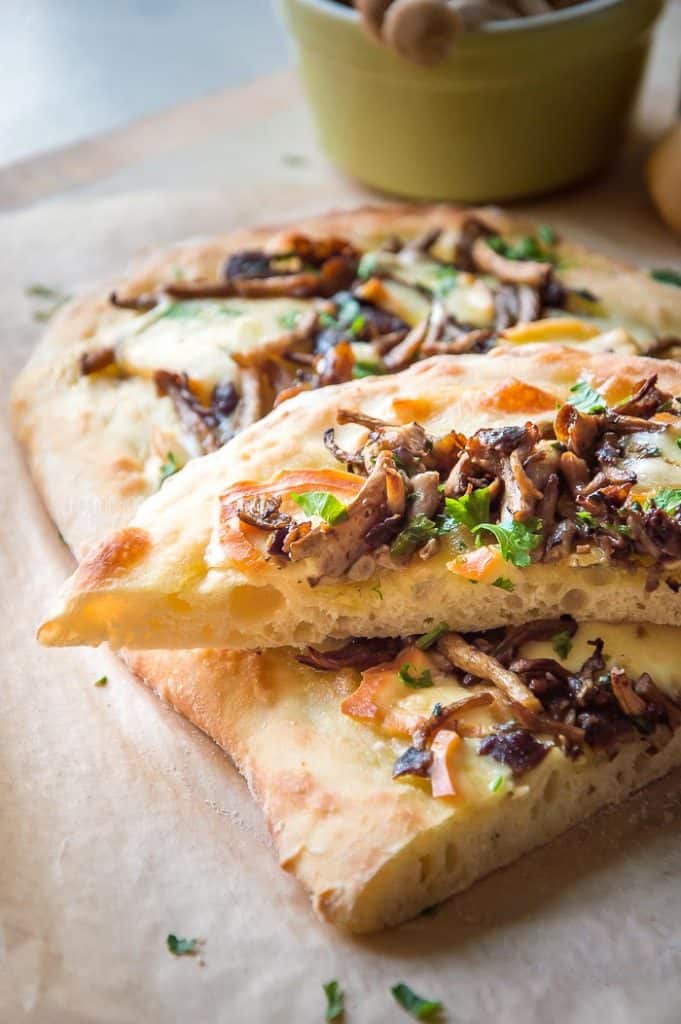
Pinsa Origin: Myths and Facts
There are many legends about the origin of Pinsa Romana, which claim that it could be an ancestor of pizza. Later revelations, however, confirm that it is a more modern than it seems.
In 2001, Corrado Di Marco and his family, already famous for having invented Pizzasnella (a less fat version of pizza), came up with the first pinsa romana as we know it, saying it was based on an ancient recipe. Their idea proved successful: in just a few years, modern pinsa romana became part of the Roman tradition and all of Italy was filled with pinserie.
Few Romans, however, remember having heard the word "pinsa" before 2001.
How is that? The answer came not long ago from Mr. Di Marco himself. In an interview, he declared that the idea for pinsa actually came from a dough that had been passed down to him from his father, and that the story of its ancient origins is nothing more than a marketing strategy "that worked well".
This is less weird than it may sound at first. After all, it would not be the first time that a dish that is considered part of the Italian tradition turns out to be a modern invention.
How To Make Pinsa - Step By Step With Pictures
Pinsa dough is the base for all types of Pinsa Romana. Once you've made the dough you can assemble it with your favorite topping.
See the recipe card for full information on ingredients and quantities.
The Night Before Baking: Make Pinsa Dough
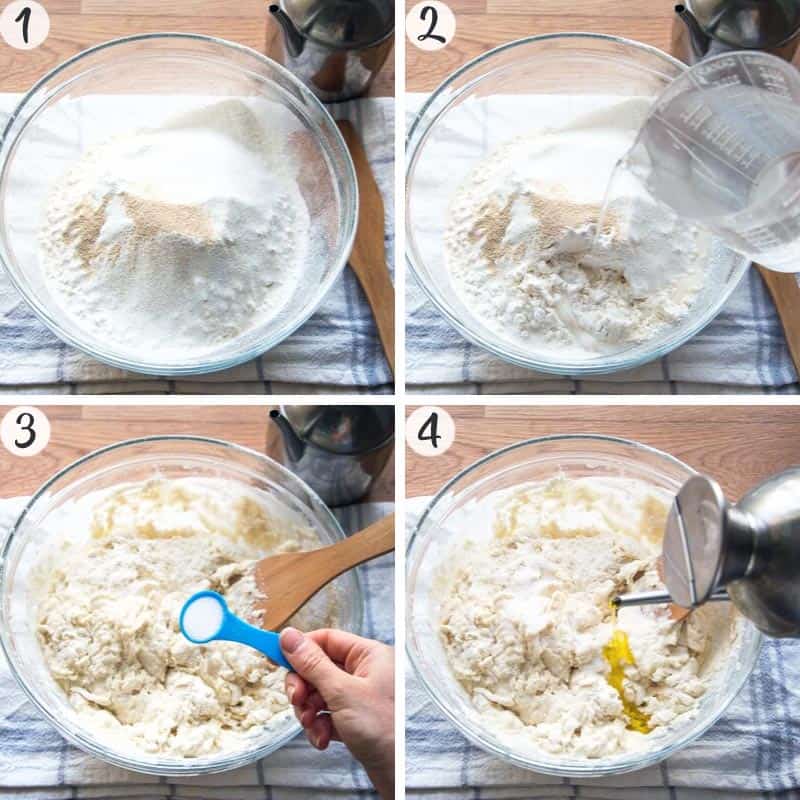
- In a large bowl mix all types of flour and yeast.
- Continuously whisking slowly add cold water.
- Add extra virgin olive oil and salt (photos 1-4).
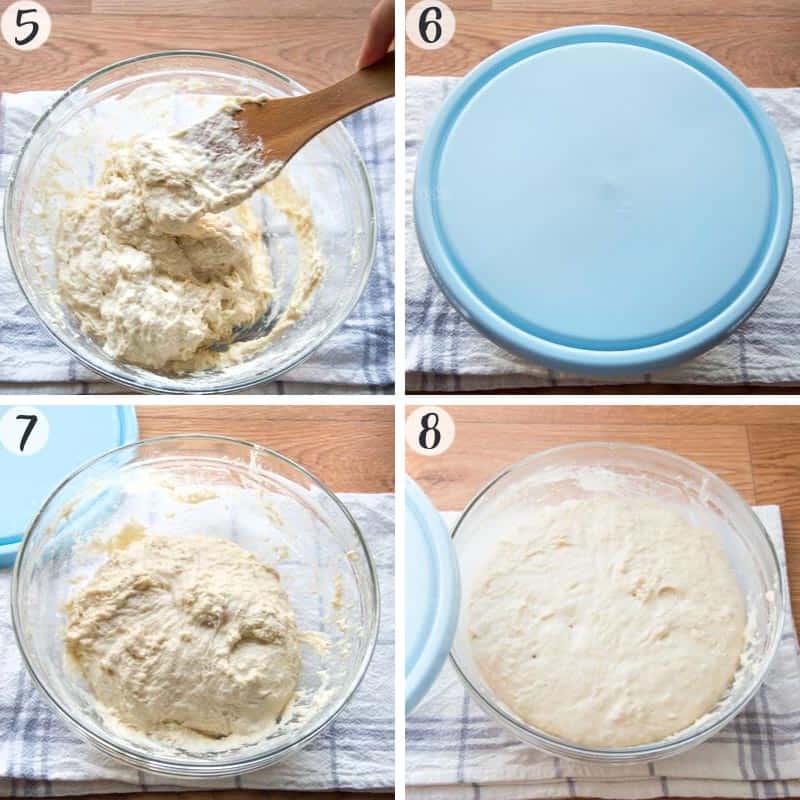
- Mix well. Cover the bowl with a plastic wrap or a lid and let rest for 30 minutes. Mix again and let rest for another 30 minutes.
- Mix with a wooden spoon for the third time.
- Now cover again with a plastic wrap or a lid and place the bowl with the dough in the fridge for about 24 hours (photos 5-8).
PAY ATTENTION: If your room temperature is lower than 80F (26C) leave the dough on the counter for 2-3 hours (depending on the room temperature) before placing it in the fridge to help start the leavening process. Here's a clue: when you notice the dough starts to rise just slightly (it should NOT double by any means) it's ready to go in the fridge overnight.
The Next Day: Divide and Shape Pinsa
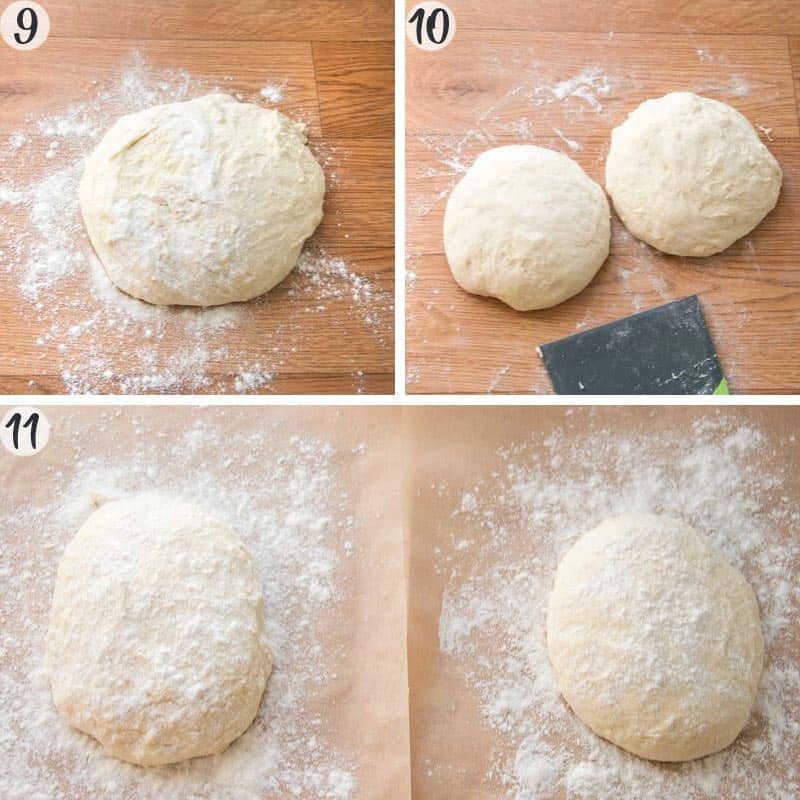
- The next day, 3-4 hours before baking, take the dough out the fridge.
- Turn the bowl upside down and let the dough come out of the bowl.
- Divide the dough in 2 parts. Using your hands form a dough ball out of each piece of dough.
- Cut 2 rectangular pieces of parchment paper that fit your baking sheet.
- Place each dough ball on a parchment paper and dust with rice flour (photos 9-11).
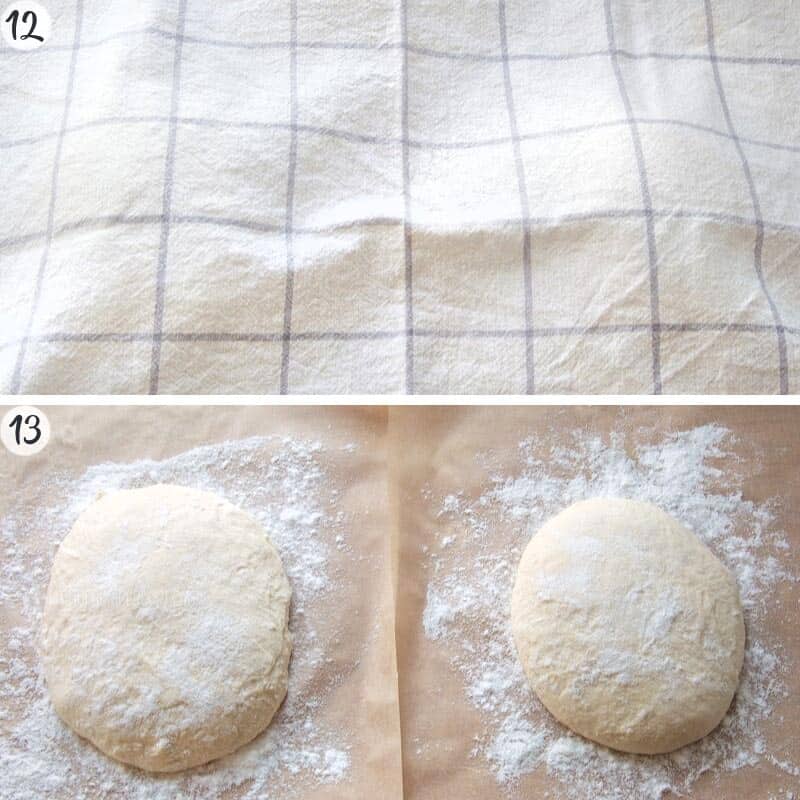
- Cover the dough with a linen towel and let rise for 60 minutes (photos 12, 13).
TIP: In the meantime prepare the mushroom topping.
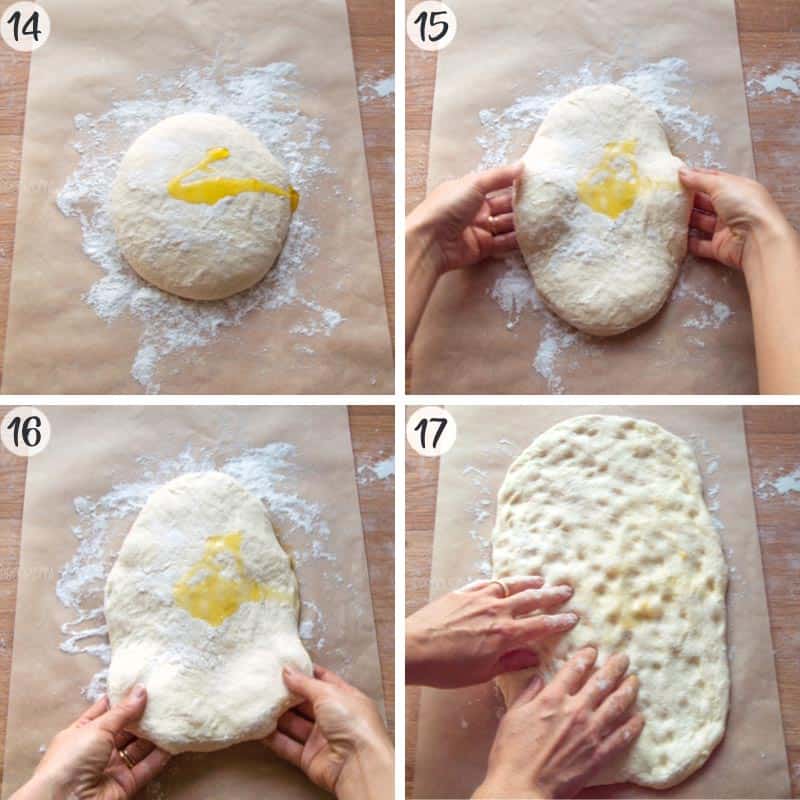
- Past that time pour a frizzle of extra virgin olive oil on each piece of the dough and using your fingers press into the dough stretching it from center to sides forming an oval pinsa shape (photos 14-17).
Bake
- Preheat the oven to 450F (230C).
- Transfer parchment paper with pinsa on a baking sheet.
- Drizzle with more extra virgin olive oil.
- Bake in a lowest part of the oven for about 10 minutes.
- Top with sauteed mushrooms and smoked provolone slices and bake againfor another 5-6 minutes or until pinsa has browned on the edges and cheese has melted.
- Garnish with chopped parsley, and freshly grind pepper.
Pinsa Toppings
Any kind of pizza topping is also suitable for pinsa, because pinsa is a kind of pizza after all. The major difference is in the dough, not the topping.
You can do anything from classic Margherita (mozzarella + tomato sauce + oregano) to something special with fall flavor like Pinsa with Mushrooms and Smoked Provolone Cheese following this recipe.
FAQs
The name of this recipe might be confusing, as there is another much more famous Italian food that is similar to it - pizza. Both foods are made of baked dough and can be topped with the same ingredients. The difference lies in the type of dough, its preparation technique and of course the region where it originated.
Pinsa comes from Rome, Lazio region, while Neapolitan Pizza comes from Naples, Campania region of Italy.
Its name comes from the Latin “pinsère” which means to stretch, press down, and extend – the technique used to shape pizza and focaccia genovese. In fact, Pinsa is a sort of mix between the two.
More Baked Goods
If you love Pinsa Romana, you'll also love:

Love Italian Food?
Sign up for our weekly newsletter to receive tips, tricks and new recipes delivered straight to your inbox!
Full Recipe
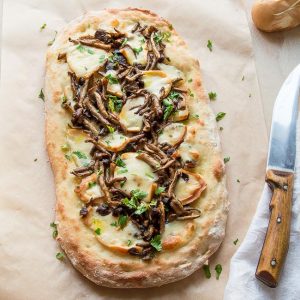
Pinsa Romana (Easy Dough Recipe and Toppings)
Ingredients
Pinsa Dough:
- 1 cup all purpose flour , 120 g
- 2 ½ bread flour , 300 g
- ½ cup rice flour , 80 g
- 1 ⅔ cup cold water , 400 g
- 1 tablespoon Extra virgin olive oil , plus more for rubbing
- ½ teaspoon dry yeast , 3 g
- 1 teaspoon salt , 9 g
Pinsa Topping with Mushrooms & Cheese
- 1 lb mushrooms of your choice , 450 g (whole or sliced)
- 12 oz smoked Provolone cheese , 350 g
- ½ cup dry white wine
- 2 garlic cloves , crushed with a flat knife
- Fresh parsley
- Extra virgin olive oil
- Salt , pepper to taste
Instructions
The Night Before Baking: Make Pinsa Dough
- In a large bowl mix all types of flour and yeast.
- Continuously whisking slowly add cold water.
- Add extra virgin olive oil and salt. Mix well. Cover the bowl with a plastic wrap or a lid and let rest for 30 minutes. Mix again and let rest for another 30 minutes.
- Mix with a wooden spoon for the third time.
- Now cover again with a plastic wrap or a lid and place the bowl with the dough in the fridge for about 24 hours.PAY ATTENTION: If your room temperature is lower than 80F (26C) leave the dough on the counter for 2-3 hours (depending on the room temperature) before placing it in the fridge to help start the leavening process. Here's a clue: when you notice the dough starts to rise just slightly (it should NOT double by any means) it's ready to go in the fridge overnight.
The Next Day: Divide and Shape Pinsa
- The next day, 3-4 hours before baking, take the dough out of the fridge.Turn the bowl upside down and let the dough come out of the bowl.
- Divide the dough in 2 parts. Using your hands form a dough ball out of each piece of the dough.
- Cut 2 rectangular pieces of parchment paper that fit your baking sheet.
- Place each dough ball on a parchment paper and dust with rice flour.
- Cover the dough with a linen towel and let rise for 60 minutes.TIP: In the meantime prepare the mushroom topping.
- Past that time pour a frizzle of extra virgin olive oil on each piece of the dough and using your fingers press into the dough stretching it from center to sides forming an oval pinsa shape.
Bake
- Preheat oven to 450F (230C).
- Transfer parchment paper with pinsa on a baking sheet.
- Drizzle with more extra virgin olive oil.
- Bake in the lowest part of the oven for about 10 minutes.
- Top with sauteed mushrooms and smoked provolone slices and bake again for 5-7 minutes or until pinsa has browned on the edges and cheese has melted.
- Garnish with chopped parsley, and freshly grind pepper.
Pinsa Topping With Mushrooms & Cheese
- Cut provolone cheese in slices.
- Add dry white wine and simmer for another few minutes. Add chopped parsley, salt and pepper to taste. Set aside.
- Add clean sliced mushrooms and stir everything together. Mushrooms will release liquid. Continue cooking for another 5-6 minutes until there’s no more liquid.
- Add olive oil and garlic cloves crushed with a flat knife or minced if you like more pronounced garlic flavor. Saute for a minute or two.
- Place a large skillet pan over medium heat.
Notes
Nutrition
Nutrition information is automatically calculated, so should only be used as an approximation.

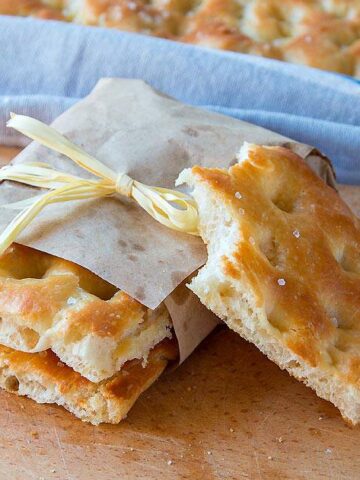
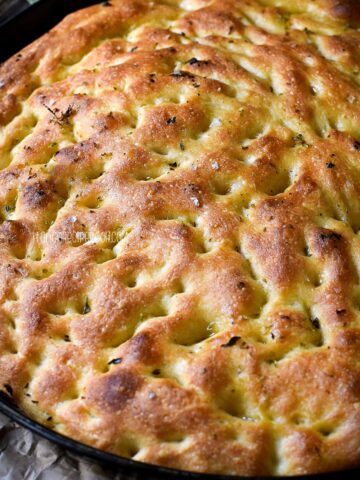
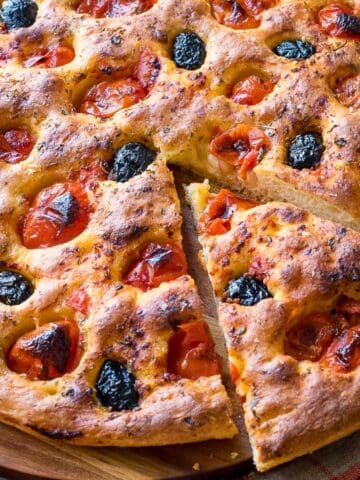
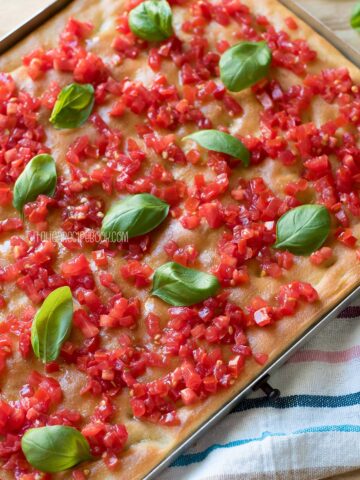
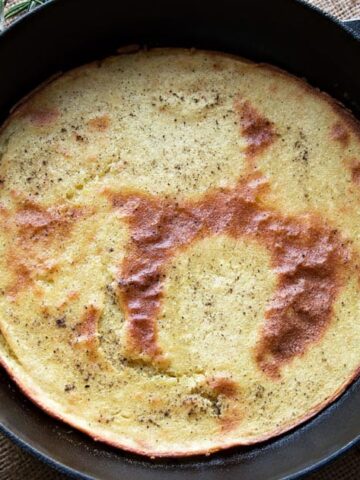
Karen says
Dough is in second rest period right now. It is incredibly stiff and I have had to mix it first and second times with my hands. I have measured very carefully (cups not grams). Suggestions before the third rest?
Svitlana says
Knead the dough using a mixer (hand-held it fine) with a dough hook and add 2 tablespoon of water, knead again and add more if needed. I also recommend next time, measure ingredients with a scale for the best result.
Steve Frankel says
This is a very good recipe. I used AP flour for the Bread flour but substituted in10g of gluten flour(410g AP, 10g Gluten). I used a whole packet of dry yeast, which weighed 7g but seemed to work fine. I was in a hurry and made one pinsa the same day and one the next day. The same-day pinsa was very good, bit the overnight fermentation really improved the flavor and crisp. I used a sauce on one of the pinsa and that didn't work well and made the pinsa soggy. The sauted mushrooms worked very well.
Svitlana says
Glad you loved it, Steve! Yes, overnight proofing does make a difference both in flavor and texture.
steve says
Hi, I really like your recipes, mainly because you give proper measurements unlike most sites with their stupid cups etc. you also seem to know what you’re talking about, which is pretty rare on the www.
Lucky me, I have some soya flour! I’m going to try the pinsa with just 35g, do you think that’s enough?
Svitlana says
Hi Steve, thank you for your kind words!
Yes, absolutely use soya flour if you have it.
Use 35-40 grams of soya flour instead of 35-40 grams of all-purpose flour so that you still work with 500 grams of flour total.
Let me know how it goes 🙂
leon says
I made this recipe tonight. I think your ratio of flour to water and yeast is not correct. The pinsa base came out doughy not light and airy as expected
Rick says
Interesting read 🙂
One minor thing. You have "Spelled has been very important because it is the ancestor of the current wheat." That should, of course, refer to Spelt, not Spelled.
Ulrich Koch says
Found the problem. But no solution. The calculator isn't working properly. It seems that 1 cup is 420g, because it never changes. 5.25 cups of flour and 0.75 cups rice flour. Totally 2.265kg flour for 3 servings cannot be correct either.
Use grams and ml in the calculator instead of cups, tbsp, etc.
Google says a tbsp is 15g but it also says it's 5g. Who is right? 1g is 1g. Always, also in the Google universe
Zenon Zinonos says
@Ulrich Koch, 1 cup of water = 250ml. You cannot convert cups or Tbsp to g across the board, because different ingredients do not weigh the same. Therefore a standard measure would be cups and tsp or Tbsp. I made this recipe today and it was fine. Very sticky (because of the hydration %) but the result was very good. Just stick to the units of measurement in the recipe and you’ll be ok!
Rosie says
A tablespoon is 15ml not grams
Ulrich Koch says
What is a cup water? 236ml
For 3 pinsas I need 2.5 cups and 500g flour. That means 120% hydration? Really?
Zenon Zinonos says
@Ulrich Koch, 1 2/3 cups water = 410g. Flour = 500g therefore hydration is approximately 82%
Renee says
Hi! What would be the difference (aside from simplicity) of using soy flour in the pinsa dough vs not including soy flour, like in your recipe? It has been difficult to find soy flour and I’m doubting whether or not the Romans used it! If it’s a big difference, I’ll have to order. Just curious, thanks!
Michele says
Hi,
This is Mike, we own a pinsa & food distribution business in US .
It's possibile to speak with you about sponsored content in one of Your page/post?
Thanks and regards
Michele
Italian Recipe Book says
Hi Mike, thank you for contacting! Please send me an email with more details as to what you're looking for at [email protected] and we can discuss further.
CHARLES WYNN says
Very interesting and excited to see future recipes.
Chris says
I followed the recipe using, soy, rice and what flour but it’s very sticky and has not doubled in size? What did I do wrong
Italian Recipe Book says
Hi Chris, it looks like you had a good start - the dough should pretty sticky. In fact, you manage it with a spatula in the beginning of the process. If the dough did not double in size but still had a good rise there's not problem at all. See my picture 7 and 8.
In case the dough had a poor rise and you're sure of your yeast quality this means the room temperature was too cold. The solution is to let the dough rest on the counter for 2-3 hours BEFORE placing it in the fridge overnight.